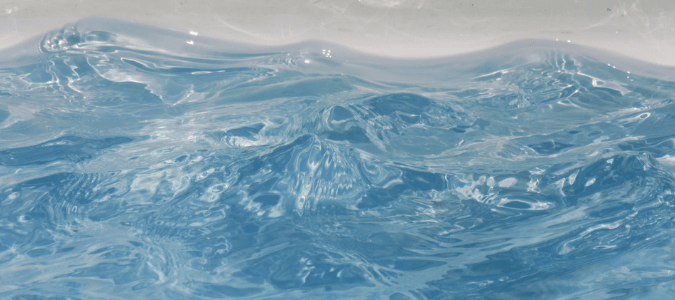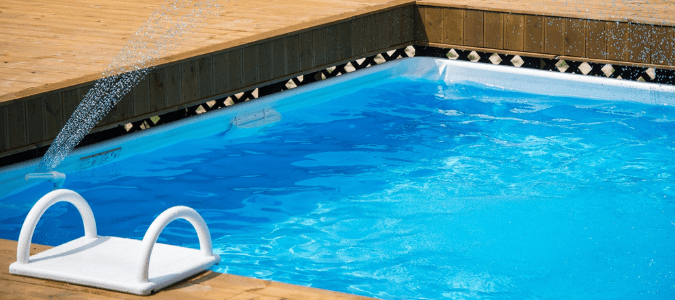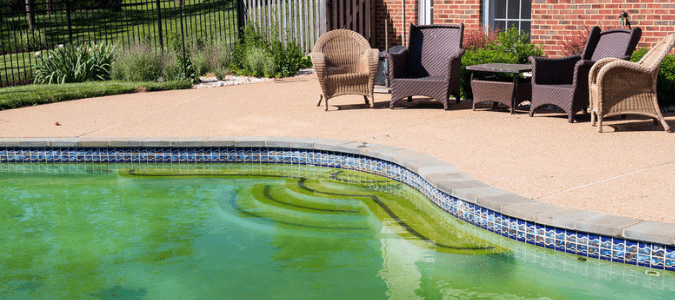
It can be a nasty shock when you discover that the normally clear, sky-blue water in your pool turned green overnight. Why is my pool green? Typically, algae is the source of green pool water, and it’s certainly possible that it took over quickly, even overnight. This is especially likely if it is very warm outside, since algae blooms more rapidly in warmer temperatures. It is even more common, however, for there to have been an ongoing, undetected chemical imbalance in your pool water that enabled algae to grow.
As a rule of thumb, the deeper the shade of green, the more algae has bloomed. If your pool has just a mild green tint to it, that’s a good thing—it means you’ve likely noticed the problem before it has gone too far, which should make it easier to treat. The first step toward getting your pool back to normal? Determining the cause of the algae growth.
Too-low levels of chlorine are the likely culprit of a chemical imbalance that leads to algae. When there is not enough chlorine in your pool water, green algae—which can float freely or attach to the walls and floor of your pool—can grow. Thus, in many cases, the most efficient way to get rid of algae is by shocking your pool water with chlorine.
There are a number of ways to treat your pool with chlorine, some of which can be handled on your own; others are best overseen by a pool specialist. Ultimately, the best way to protect your pool is with a solid maintenance schedule, in order to prevent problems before they develop.
Let’s take a look at the process of shocking your pool as well as other reasons that your pool might have changed color.
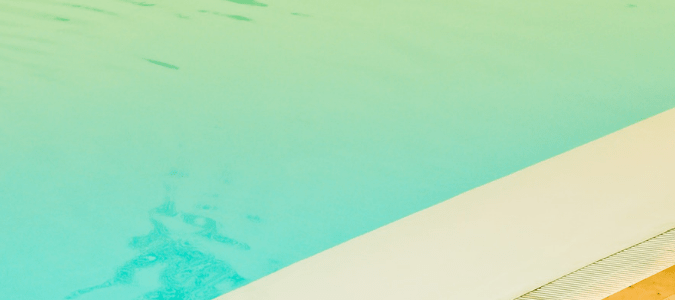
Green Pool Water: Not Algae, So Could It Be Something Else?
Before we get into how to shock your pool in order to eliminate unsightly algae blooms, let’s take a look at some of the other potential causes of green water. After all, sometimes this problem is not related to inadequate chlorine levels allowing algae to grow—so what could be causing that nasty, sickly hue?
Sometimes, green pool water can be related to the size and power of your pool’s pump and filter. If they are too small for your pool, a buildup of algae can result. If your pool has the proper size of pump and filter but you don’t run the filter long enough every night—eight hours per night is recommended—it may not be able to clear algae spores efficiently.
Filtration issues causing color changes in the water can also be connected to which type of filter you have installed in your pool. If your pool has a sand filter, clearing the pool of whatever is making it murky and green may take a week, or even longer. If your pool has a cartridge filter, you may need to clean the cartridge every single day until the pool water is completely clear and back to normal.
It is also possible that a pool can turn green from exposure to oxidized copper. This is a rare occurrence, since it can happen only when pool water comes in contact with copper, usually via corrosion in copper heaters. This probably isn’t the source of your problem, unless you have oxidized copper somewhere in your pool. If you do believe oxidized copper is the source of your green water, it’s a good idea to call in a pool specialist to conduct a thorough evaluation, starting with testing the water and its chemical levels to check for an imbalance.
How To Turn A Green Pool Blue Fast: Shock Your Pool
If you’re wondering how to turn a green pool blue fast, you aren’t alone; any homeowner faced with a suddenly pea-green pool wants to know how to restore it to its normal shade as quickly as possible.
In most cases, the quickest way to turn your green pool blue is to shock it. This is also called super-chlorination, and it is the process of adding enough chemicals—usually chlorine, but sometimes something else—to eliminate built-up chloramines, along with algae, bacteria and other organic matter.
Shocking your pool is a multi-step process, and it can feel intimidating to handle so many chemicals. Many people manage this successfully on their own, while others prefer to have a professional shock their pool for them, to ensure that they get the complex balance of chemicals exactly right. Either way is fine, as long as you feel your pool is getting what it needs—and as long as it works, meaning that your pool returns to a normal, clear, beautiful blue.
If you choose to try shocking your pool yourself, you’ll first need to test your water, balance your pool chemistry, check your filter and clean your pool, including clearing away leaves and brushing down surfaces. You’ll also need to make sure the pool is filled to its normal level and the water’s pH is within the normal range, which is between 7.2 and 7.6. The lower range of that scale is best for most pools before receiving a shock treatment; if the pH is too high, the shock will make the water cloudy, and shocking also raises the pH overall. The water’s alkalinity should also be between 80 and 120 ppm.
Next, you’ll need to determine whether to use liquid chlorine or granular shock, which depends on which type of filter you have installed in your pool. Pools with cartridge or sand filters can use liquid chlorine, while pools with diatomaceous earth filters should use granular shock. Calculating the right type and amount of chemical needed also depends on knowing the volume of water that your swimming pool holds. Generally speaking, it is best to use one or two pounds of shock for every 10,000 gallons of water.
Check the package to see if the product needs any preparation before use, as some shock products must be dissolved in water first, while others can be added as-is directly to the pool. If you need to dissolve your shock first, you can fill a bucket with five gallons of warm water and add the shock to the water while stirring gently.
After pouring the shock (or shock mixture) evenly around your pool, run the filtration pump for at least 24 hours to clear contaminants, germs and algae from the pool. In some cases, it takes several days of constant filtration for the pool water to be restored to its normal clarity and color.
Most pools can be shocked on a monthly basis in order to keep the water clear and free of contaminants. Always wait at least 24 hours after shocking your pool before going for a swim.
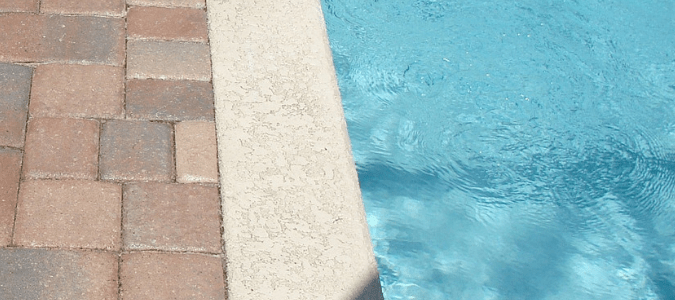
My Pool Is Green But Chlorine Is High: What Else Could Be The Problem?
If your pool is green but chlorine is high, it’s possible that you aren’t running the pool’s filter often enough or for long enough to filter out algae and bacteria. In spring and summer, when it’s warm outside, pools should be filtered for eight hours a day, regardless of whether the pool is in active use. During cooler months, filtration time can be shorter; four hours a day should be sufficient. Again, pools should always be filtered regularly, even if no one is swimming in them.
It is also possible that copper somewhere in your pool is causing the water to turn green, despite the pool’s chlorine content. Chelating agents for removing copper are available at most swimming pool stores, if you’re tackling the problem yourself, or a pool specialist can apply the treatment for you.
How To Keep Pool From Turning Green: Maintenance Tips For Clear, Blue Water
The best way to keep your pool clear and blue is with regular maintenance. There are a number of preventative actions that homeowners can manage on their own, which can be considered pool maintenance for beginners, such as removing debris with a leaf net; others are more complex and may be better handled by a professional.
Wipe The Tile Line And Clean Out Skimmer Baskets
The tile line in your pool should be wiped down every week in order to prevent build-up, and the skimmer baskets—the baskets located along the sides of the pool that collect debris from the surface of the water—should also be emptied routinely.
Clean Pool Filters Regularly
Cartridge filters should be cleaned every two to six weeks, diatomaceous earth filters should be back-washed every one to three months and sand filters should be back-washed every one to four weeks.
Size Your Pool’s Pump and Filters
Having an undersized pool filter and pump can lead to a green pool. While filters collect debris, pumps circulate water in the pool. Since numerous variables go into choosing the proper size of pump and filter for your pool, an experienced pool professional is your best bet for getting good advice that will work for your pool.
Check Your Pool’s Chemistry
Test your pool’s pH level and chemical balance once or twice a week during the summer and once every week or two during the winter. The proper pH range is between 7.2 and 7.8, and the ideal pH for most pools is 7.4 or 7.6.
Shock Your Pool On A Monthly Basis
As mentioned previously, shocking your pool on a monthly basis will help prevent the growth of algae, bacteria and other contaminants.
ABC Can Keep Your Pool Looking And Working Great
Not only does a green swimming pool look uninviting, it can also be a difficult and time-consuming process to figure out the right blend of steps and chemicals to fix the problem. For many of us, testing pool water, handling chemicals and keeping up with regular pool maintenance is just too much to take on. The pool professionals at ABC Home & Commercial Services can make your life easier by providing regular maintenance as well as troubleshooting any problems that may crop up on occasion, such as water turning green overnight. We’ll ensure that your pool’s chemical levels remain in balance so that algae is never able to bloom. Leave the hard work to us, so you can spend your time enjoying your pool.
